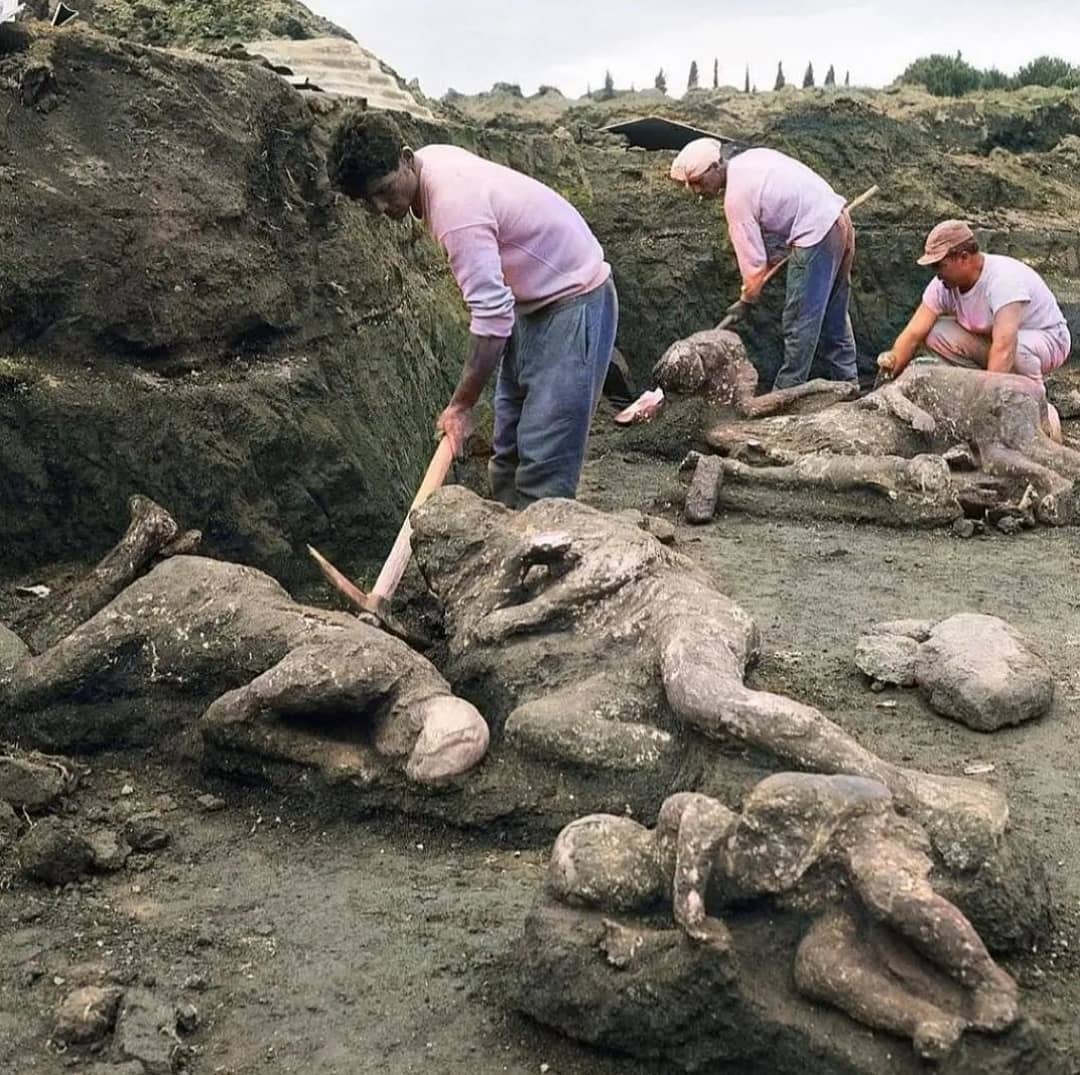Pompeii, one of the most famous archaeological sites in the world, stands as a haunting yet fascinating testament to the power of nature and the fragility of human civilization. Located in Campania, Italy, about 14 miles (23 km) southeast of Naples, the city thrived as a prosperous Roman settlement before it met its tragic fate. On August 24, 79 CE, Mount Vesuvius erupted with catastrophic force, burying Pompeii under a thick blanket of volcanic ash and pumice. The eruption, which lasted for two days, was so intense that it preserved the city in near-perfect condition, freezing its people, buildings, and daily life in an eerie snapshot of ancient history.
Today, Pompeii serves as an open window into the past, offering invaluable insights into Roman society, culture, and urban planning. The city’s sudden destruction paradoxically ensured its preservation, allowing modern archaeologists to study a civilization that would have otherwise been lost to time.
The Prosperous City of Pompeii
Before its destruction, Pompeii was a thriving Roman city, home to an estimated 11,000 to 15,000 people. Situated near the Bay of Naples, it was an important commercial hub, benefiting from its fertile land, trade routes, and strategic coastal location. The city was famous for its luxurious villas, grand temples, bustling marketplaces, and vibrant social life. Wealthy Romans built opulent homes adorned with intricate frescoes, mosaics, and sculptures, while the working class engaged in commerce, farming, and various trades.
Pompeii’s streets were lined with taverns, shops, public baths, and even brothels, reflecting the city’s diverse and dynamic culture. The city’s infrastructure was highly advanced for its time, featuring an efficient water supply system, sophisticated road networks, and a well-planned layout that showcased Roman engineering ingenuity.
Despite its prosperity, the people of Pompeii were unaware of the impending doom that lurked just miles away. Mount Vesuvius had been dormant for centuries, and there were no written records to warn them of its destructive potential.
The Cataclysmic Eruption of Mount Vesuvius
On August 24, 79 CE, the tranquility of Pompeii was shattered by a massive eruption from Mount Vesuvius. According to historical accounts, particularly from the Roman writer Pliny the Younger, the disaster began around noon when a column of volcanic ash and rock shot miles into the sky. For several hours, the sky darkened as a thick layer of ash rained down upon the city, collapsing roofs, clogging streets, and suffocating residents. Many attempted to flee, but the chaotic scene made escape difficult.
As night fell, an even deadlier phase of the eruption began. Pyroclastic surges—blisteringly hot clouds of toxic gas and volcanic debris—rushed down the mountainside at speeds exceeding 100 miles per hour (160 km/h). These surges were so intense that they instantly incinerated and suffocated anyone in their path. Entire families, frozen in time, were found in their homes, their final moments preserved by the ash that covered them.
By the morning of August 25, Pompeii had been completely buried under up to 20 feet (6 meters) of ash and pumice. The once-thriving city was no more, its people lost beneath the weight of volcanic destruction.
Rediscovery and Excavation
For over 1,500 years, Pompeii lay forgotten, hidden beneath layers of volcanic debris. It wasn’t until the late 16th century that its remains were accidentally discovered during the construction of an underground canal. However, serious excavation efforts did not begin until the 18th century, when explorers realized the significance of the site.
What archaeologists found was astonishing. Pompeii was not just a city buried in ash—it was a remarkably preserved time capsule of Roman life. Streets, homes, temples, and even graffiti on walls remained intact. Plaster casts of human bodies, created by filling voids in the ash, provided a haunting glimpse of the people’s final moments. The frozen expressions of agony, the postures of those shielding loved ones, and even animals caught in the disaster painted a vivid picture of the tragedy.
Some of the most remarkable discoveries include:
-
The Forum – The political and economic heart of the city, lined with public buildings, markets, and temples.
-
The House of the Vettii – A well-preserved aristocratic villa featuring beautiful frescoes and elaborate decorations.
-
The Lupanar – A famous brothel with explicit frescoes depicting scenes of ancient Roman eroticism.
-
The Amphitheater – One of the oldest surviving Roman amphitheaters, used for gladiator battles and entertainment.
-
Graffiti and Inscriptions – Personal messages, political slogans, and humorous writings that offer insight into the thoughts and humor of the people of Pompeii.
Life in Pompeii: What the Ruins Reveal
Through excavations, historians have pieced together a detailed understanding of daily life in Pompeii. The city was a bustling urban center where social classes mixed, businesses thrived, and entertainment flourished.
-
Trade and Economy – Pompeii’s economy revolved around agriculture, trade, and craftsmanship. The region’s volcanic soil was exceptionally fertile, making it ideal for vineyards and olive groves. Wine from Pompeii was highly prized, and archaeologists have found numerous wine jugs with inscriptions indicating their origins. Shops, bakeries, and taverns lined the streets, showing a thriving middle-class presence.
-
Social Life and Leisure – The people of Pompeii enjoyed a variety of entertainment options. The city had theaters for performances, an amphitheater for gladiatorial combat, and public baths where Romans socialized, conducted business, and relaxed.
-
Religion and Temples – The city housed numerous temples dedicated to Roman gods such as Jupiter, Apollo, and Venus. Evidence also suggests the influence of Egyptian and Greek religious practices.
-
Art and Culture – The walls of Pompeii’s homes were decorated with elaborate frescoes depicting mythology, nature, and everyday life. Many of these frescoes remain vivid despite the passage of nearly 2,000 years.
The Lasting Legacy of Pompeii
Pompeii remains one of the most visited archaeological sites in the world, drawing millions of tourists each year. Its preservation offers an unparalleled glimpse into the past, allowing historians to study ancient Roman life in extraordinary detail. Unlike other historical sites that have been gradually altered or destroyed over time, Pompeii provides a frozen moment in history, untouched by centuries of human intervention.
Beyond its historical value, the destruction of Pompeii serves as a powerful reminder of nature’s unpredictable fury. Mount Vesuvius remains an active volcano, and the modern cities of Naples and surrounding towns sit within its danger zone. Scientists continue to monitor the volcano, aware that another catastrophic eruption could one day occur.
The ongoing excavation and preservation efforts at Pompeii ensure that future generations will continue to learn from its past. As researchers uncover new artifacts, frescoes, and even human remains, the story of Pompeii continues to evolve, offering fresh insights into the lives of those who once called it home.
Conclusion
Pompeii stands as both a tragedy and a treasure. While the eruption of Mount Vesuvius marked the devastating end of a thriving Roman city, it also preserved an unprecedented record of ancient life. The ruins of Pompeii, with their eerily lifelike plaster casts, frozen streets, and remarkably intact buildings, continue to captivate historians, archaeologists, and visitors alike.
The echoes of Pompeii remind us of the fragility of civilization and the immense power of nature. As we walk through its ancient streets today, we do so as witnesses to a city that, though silenced by disaster, speaks volumes through the ashes of time.

